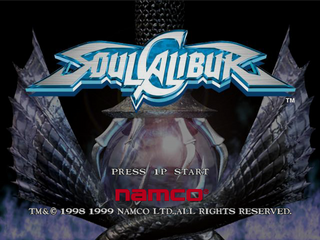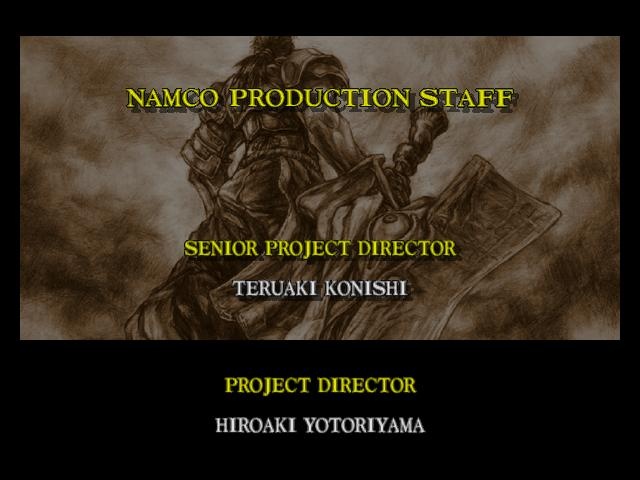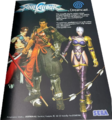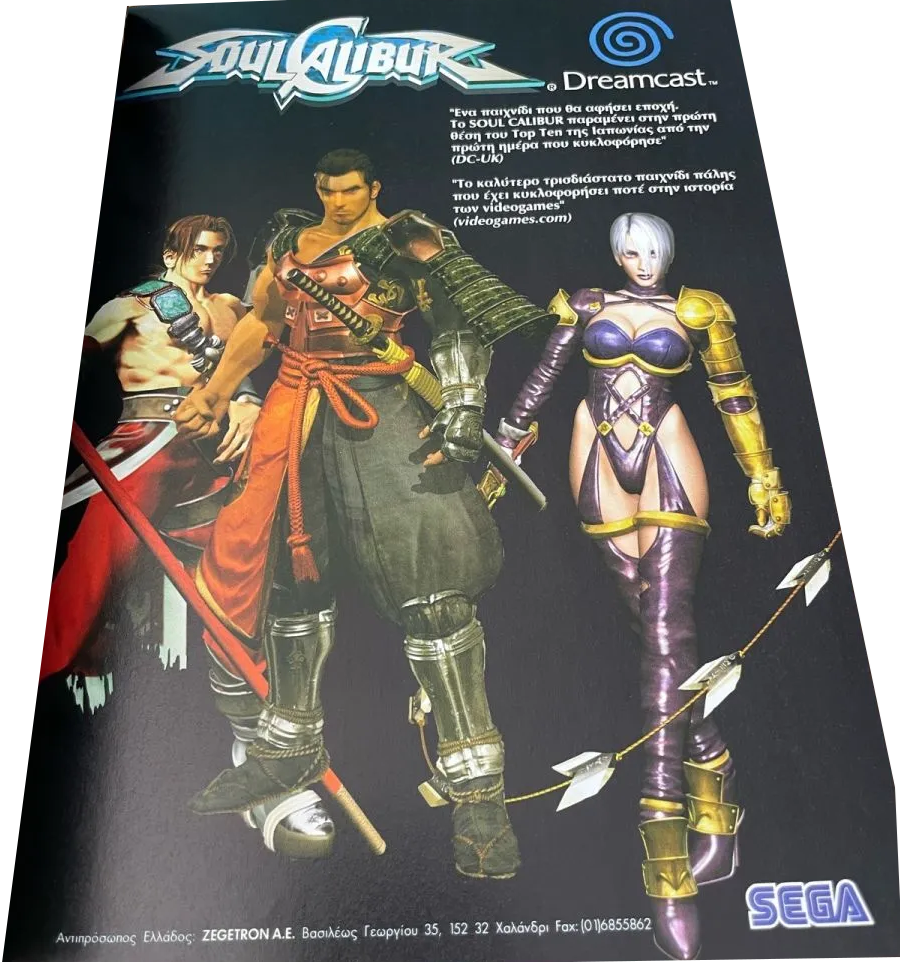SoulCalibur
From Sega Retro
| SoulCalibur | ||||||||||||||||||||||||||||||||||||||||||||||||||
|---|---|---|---|---|---|---|---|---|---|---|---|---|---|---|---|---|---|---|---|---|---|---|---|---|---|---|---|---|---|---|---|---|---|---|---|---|---|---|---|---|---|---|---|---|---|---|---|---|---|---|
| System(s): Sega Dreamcast | ||||||||||||||||||||||||||||||||||||||||||||||||||
Publisher: Namco
Namco Hometek (US)
| ||||||||||||||||||||||||||||||||||||||||||||||||||
| Developer: Namco | ||||||||||||||||||||||||||||||||||||||||||||||||||
| Distributor: Sega Europe[1] (Europe) | ||||||||||||||||||||||||||||||||||||||||||||||||||
| Original system(s): Namco System 12 | ||||||||||||||||||||||||||||||||||||||||||||||||||
| Peripherals supported: Dreamcast Arcade Stick, Fishing Controller, Jump Pack, Dreamcast Modem, Dreamcast VGA Box, Visual Memory Unit | ||||||||||||||||||||||||||||||||||||||||||||||||||
| Genre: Fighting/Kakutou (挌闘)[2], 3D Buki Taisen Kakutou/3D Weapon Fighting (3D武器対戦挌闘)[3], Action[4] | ||||||||||||||||||||||||||||||||||||||||||||||||||
| Number of players: 1-2 | ||||||||||||||||||||||||||||||||||||||||||||||||||
| Official in-game languages: | ||||||||||||||||||||||||||||||||||||||||||||||||||
| ||||||||||||||||||||||||||||||||||||||||||||||||||
|
SoulCalibur (ソウルキャリバー SōruKyaribā) is a versus fighting game developed by Namco and is the sequel to Soul Edge/Soul Blade. Originally released for Namco System 12 arcade hardware, the game was ported to the Sega Dreamcast with improved graphics and extra features. It was a launch title in North America. The European Dreamcast version was distributed and advertised by Sega Europe.
The Dreamcast version of the game has often been cited as one of the greatest fighting games ever made, being the highest rated Dreamcast game in existence. It has since been re-released on the Xbox Live Arcade service. SoulCalibur was followed by SoulCalibur II for the Nintendo GameCube, PlayStation 2 and Xbox, though did not receive the same amount of praise as its predecessor.
Contents
Story
Gameplay
Characters
| Voldo | |
|---|---|
| Ivy | |
| Sophitia | |
| Mitsurugi | |
| Kilik | |
| Xianghua | |
| Maxi | |
| Maxi is seen as a replacement for Li Long in Soul Edge, a character who would not return to the series until SoulCalibur III in 2005. | |
| Nightmare | |
| Taki | |
| Astaroth | |
| Hwang | |
| Unlockable | |
| Yoshimitsu | |
| Unlockable | |
| Lizardman | |
| Unlockable | |
| Seigfried | |
| Unlockable | |
| Rock | |
| Unlockable | |
| Seung Mina | |
| Unlockable | |
| Cervantes | |
| Unlockable. Cervantes is exclusive to the Dreamcast version of the game. | |
| Edge Master | |
| Unlockable | |
| Inferno | |
| Unlockable |
History
Development
It is thought that SoulCalibur was named as such due to trademark issues with its prequel, Soul Edge. Tim Langdell, owner of video game company Edge Games, had trademarked the term "edge" and aggressively challenged video game media which sought to use the name in the US, leading to Namco releasing Soul Edge as Soul Blade in Western territories. The entire series was renamed SoulCalibur to keep things consistent, and "Caliber" was thought to be purposefully misspelled to avoid a similar situation occuring again. Langdell was forced to drop claims of ownership over the "edge" name after challenged by Electronic Arts and their 2008 game, Mirror's Edge.
Release
While the game debuted at number one in Japan, SoulCalibur struggled to keep a high position in the weekly charts. Namco, disappointed with the game's sales, reportedly pulled out of Dreamcast development (save for some lower-budget titles and compilations) as a result[17]. The decision was controversial, as the game had yet to be released overseas at the time. It would go on to sell over 1.3 million copies worldwide[18].
Versions
Arcade vs. Dreamcast
Compared to the arcade version, the Dreamcast version features improved graphics, including newly added 3D backgrounds. The gameplay has been tweaked, and enriched with new game modes, new costumes, and an extra character, Cervantes de Leon. New modes such as the Team Battle, Survival and the Training Mode are also included. In Missions Mode the player completes various missions to attain points, which can be used to buy various art and costumes. The new artwork section containins official artwork, fanart and high resolution pictures.
Extra unlockables include "liquid metal' character costumes, a "Battle Theater" mode, the ability to modify the opening introduction theme by changing the characters appearing in it and an "Exhibition Mode" displaying characters performing their katas. In Mission Mode it is possible to add more characters to the "Exhibition Mode", such as Taki and Seung Mina).
Regional differences
The North American version of the game removed one of Voldo's suggestive codpieces featuring a bull. However, it is present in the European and Japanese versions.
Xbox Live Arcade
The Xbox Live Arcade re-release was a port based on the European Dreamcast version and was made available for download on Xbox Live Arcade on July 2, 2008. While the game included high-definition updated graphics and various Live leaderboards, online play was absent which makes it an exception amongst most games ported to Xbox Live Arcade. Other features from the Dreamcast version (Museum, etc., with the exception of Mission Battle) are also in the game. While the intro itself is removed from this port, the intro music still exists. All content is unlocked by the start of the game.
Production credits
- Senior Project Director: Teruaki Konishi
- Project Director: Hiroaki Yotoriyama
- Production Manager: Koh Onda
- Motion Design Director: Masataka Ishiguro
- Mission Battle Mode & Effects Supervisor: Tadashi Iguchi
- Motion Capture Director: Jin Okubo
- Motion Management: Naotake Hirata
- Practice Mode Director: Tetsuya Akatsuka
- Motion Design Co-Director: Kazuo Takahashi
- Museum Mode & Enemy AI Director: Yoshito Higuchi
- Tuning Director: Makoto Kiyokawa
- Mission Battle Mode Coordinator: Yoshihiro Nakagawa
- Lead Programmer: Shinobu Nimura
- 3D System Programmer: Shizuka Matsuda
- Stage Effects & Enemy AI Programmer: Yoshihito Iwanaga
- Motion & Mission Battle Mode Programmer: Takashi Koshigoe
- Sound & Special Effects Programmer: Tadashi Obama
- Opening Demo & Camera Motion Programmer: Masaaki Hoshino
- Interface Programmer: Hiroyuki Kobota
- CGI Programmer: Teppei Kusakabe
- Network System Support: Ryuunosuke Okazaki
- Skeleton Model & Motion Design: Yoshihisa Yaguchi
- Motion Design: Yukie Misaki, Nobuko Nimura, Tomoe Hirata, Naoko Ishizu, Isamu Sawada, Kaori Satoh, Shouji Nakamura
- Lead Artist: Ryoichi Ban
- 3D Model & Texture Design: Akira Nakajima, Takeya Inoguchi, Yukiharu Taniguchi, Hiroaki Kado, Seido Ozawa, Hideo Yoshie, Masato Inagaki
- Lead Artist: Kanako Iwasaki
- 3D Model & Texture Design: Hiroko Noguchi, Tomoko Tomita, Momoko Daigo, Yasunori Yanagawa
- Director: Yasushi Shibue
- Design: Yukiko Yokoo, Fuminori Tsuchiya, Sachiko Inoue
- 2D Graphics & LCD Character Design: Taro Okamoto
- Original Character Design: Kouji Mitsunaga
- Title Logo & Graphic Design: Hideaki Ito
- 2D Character Illustrations: Kiyotaka Tamiya
- Package Design: Minako Matsuda
- Interface Coordination: James Lisle
- Music: Junichi Nakatsuru
- Additional Music Production: Akitaka Tohyama, Yoshihito Yano, Takanori Otsuka
- Sound Effects: Hideki Tobeta
- Voice Talents
- Kilik: Souichiro Hoshi
- Xianghua: Aya Hisakawa
- Maxi: Nobutoshi Hayashi
- Mitsurugi: Toshiyuki Morikawa
- Taki: Fujiko Takimoto
- Sophita: Michiko Neya
- Astaroth: Banjo Ginga
- Ivy: Yumi Touma
- Narrator: Jeffry Maning
- Hwang: Wataru Takagi
- Yoshimitsu/Siegfried/Nightmare: Nobuyuki Hiyama
- Rock: Takashi Nagasako
- Seung Mina: Houko Kuwashima
- Cervantes: Takashi Nagasako
- Edge Master: Daisuke Gouri
- Motion Capture Tech. Team: Takayasu Yanagihara, Satoshi Yamaguchi, Miho Nakasaka, Toshiyuki Hagiwara
- MS Team: Tetsuya Kono, Kumiko Naemura
- Motion Capture Actors: Kenichiro Tamayori, Takayuki Nakayama, Ken Shibata, Li Tianyuan, Jiang Chi
- Tuning Unit & Production Assistants: Ryoji Ichikari, George Taguchi, Tsuyoshi Kiuchi, Akiya Ikeda, Satoshi Masukawa, Norikatsu Yoshikawa, Takuji Kanayama, Shinji Takino, Yasuki Nakabayashi, Naoyuki Kondou, Takeharu Kondou, Takashi Arai
- QA Team (NTSC Version): Takashi Chida, Yusuke Morita, Shinya Suzuki, Shinya Inamoto, Miho Tanaka, Michitaka Motomura, Yasuhiro Komuro, Eriko Shiina, Ryuji Kurokawa, Yoshitomo Nakanishi, James Guirao, Dominic Lobbia
- QA Team (PAL Version): Takashi Chida, Yusuke Morita, Shinya Suzuki, Shinya Inamoto, Miho Tanaka, Michitaka Motomura, Yasuhiro Komuro, Eriko Shiina, Ryuji Kurokawa, Yoshitomo Nakanishi
- Special Thanks (NTSC Version): Kouji Kudou, Yokohama Chinese Wushu Society, Toshio Natsui, Yutaka Toya, Junichi Kawamura, Satoru Yamada, Kazuyuki Nikaido, Hiroki Tanaka, Kaname Takai, Yutaka Goto, Taku Tsuge, Kai Tanaka, Tsuyumi Toyoda, Noriko Kobayashi, Koichiro Shigeno, Hiroshi Goshowaki, Asako Ueno, Jason Arney, Masanori Kato, Jeff Miller, Jesse Taylor, Yoshi Homma, And All Namco Staff
- Special Thanks (PAL Version): Kouji Kudou, Yokohama Chinese Wushu Society, Toshio Natsui, Yutaka Toya, Junichi Kawamura, Satoru Yamada, Kazuyuki Nikaido, Hiroki Tanaka, Kaname Takai, Yutaka Goto, Taku Tsuge, Kai Tanaka, Tsuyumi Toyoda, Noriko Kobayashi, Koichiro Shigeno, Hiroshi Goshowaki, Asako Ueno, Jason Arney, Hiroaki Ochiai, SDL International, Kats Sato (Sega Europe, Ltd.), Roberto Parraga-Sanchez (Sega Europe, Ltd.), Dave Thompson (Sega Europe, Ltd.), Angelika Michitsch (Sega Europe, Ltd.), Kim Shon (Sega Europe, Ltd.), Cedric Marechal (Sega Europe, Ltd.), Jason Cumberbatch (Sega Europe, Ltd.), Ross McLeish (Sega Europe, Ltd.), Sarah Ward (Sega Europe, Ltd.), And All Namco Staff
- Production Coordinators: Toshiya Hara, Shinichi Tsuruya
- Assistant Producers (US Version) (NTSC Version): Noriko Wada, Paul Guirao
- Producer (US Version) (NTSC Version): Yasuhiro Noguchi
- Translation Staff (PAL Version): Yasuhiro Noguchi, Noriko Wada, Paul Guirao
- Executive Producers: Shukuo Ishikawa, Shigeru Yokoyama, Katsuo Nakamura
- Co-Producer: Masuya Oishi
- Producer: Hajime Nakatani
- Produced by: Namco
- TM & ©1998 1999 Namco Ltd., All Rights Reserved
Magazine articles
- Main article: SoulCalibur/Magazine articles.
Promotional material
Print advertisements
also published in:
- Official Dreamcast Magazine (US) #1: "September 1999" (1999-08-24)[20]
- GamePro (US) #133: "October 1999" (1999-xx-xx)[21]
- Official Dreamcast Magazine (US) #2: "November 1999" (1999-10-05)[22]
also published in:
- Dreamcast: Le Magazine Officiel (FR) #3: "Mars/Avril 2000" (2000-xx-xx)[23]
also published in:
- PSX Extreme (PL) #44: "04/2001" (2001-0x-xx)[29]
TV advertisements
Artwork
Physical scans
| 96 | |
|---|---|
| Based on 48 reviews | |
| Dreamcast, JP |
|---|
| Dreamcast, US |
|---|
| Dreamcast, EU |
|---|
| Dreamcast, PT |
|---|
Technical information
- Main article: SoulCalibur/Technical information.
External links
References
- ↑ http://www.ign.com/articles/1999/09/02/sega-europe-to-distribute-soul-calibur (Wayback Machine: 2014-08-02 18:30)
- ↑ File:SoulCalibur DC JP Box Back.jpg
- ↑ 3.0 3.1 3.2 http://sega.jp/dc/990601/ (Wayback Machine: 2008-01-30 13:36)
- ↑ https://sega.jp/history/hard/dreamcast/software_l.html (Wayback Machine: 2020-02-01 22:57)
- ↑ Press release: 1999-09-02: Sega Dreamcast Launch Titles and Peripherals
- ↑ http://www.sega.com:80/games/dreamcast/post_dreamcastgame.jhtml?PRODID=134 (Wayback Machine: 2003-11-07 02:35)
- ↑ GamePro, "October 1999" (US; 1999-xx-xx), page 131
- ↑ http://www.chipsworld.co.uk/detProd.asp?ProductCode=1109 (Wayback Machine: 2003-11-30 15:32)
- ↑ Computer & Video Games, "December 1999" (UK; 1999-11-xx), page 41
- ↑ https://groups.google.com/g/uk.games.video.dreamcast/c/isQpfdQvatM/m/kmdDpff0wigJ
- ↑ Computer & Video Games, "November 1999" (UK; 1999-10-13), page 77
- ↑ http://www.centromail.es/top/ficha.asp?codmail=13662&codprov= (Wayback Machine: 2001-09-17 04:36)
- ↑ 13.0 13.1 Revista Oficial Dreamcast, "Enero 2000" (ES; 1999-12-20), page 42
- ↑ http://www.micromania.fr/zooms/?ref=16075 (Wayback Machine: 2003-02-24 16:48)
- ↑ http://www.futuregamez.net:80/outnow/dc.html (Wayback Machine: 2001-07-31 23:17)
- ↑ Hyper, "October 1999" (AU; 1999-xx-xx), page 55
- ↑ Electronic Gaming Monthly, "November 1999" (US; 1999-10-05), page 58
- ↑ http://www.namcoarcade.com:80/nai_gamedisplay.asp?gam=soulcal2 (Wayback Machine: 2002-10-21 10:54)
- ↑ File:SoulCalibur Dreamcast credits.pdf
- ↑ Official Dreamcast Magazine, "September 1999" (US; 1999-08-24), page 35
- ↑ GamePro, "October 1999" (US; 1999-xx-xx), page 93
- ↑ Official Dreamcast Magazine, "November 1999" (US; 1999-10-05), page 61
- ↑ Dreamcast: Le Magazine Officiel, "Mars/Avril 2000" (FR; 2000-xx-xx), page 41
- ↑ Neo Plus, "Kwiecień 2001" (PL; 2001-xx-xx), page 100
- ↑ Neo Plus, "Maj 2001" (PL; 2001-xx-xx), page 100
- ↑ Neo Plus, "Czerwiec 2001" (PL; 2001-xx-xx), page 100
- ↑ Neo Plus, "Lipiec-Sierpień 2001" (PL; 2001-xx-xx), page 84
- ↑ Neo Plus, "Wrzesień 2001" (PL; 2001-xx-xx), page 84
- ↑ PSX Extreme, "04/2001" (PL; 2001-0x-xx), page 2
- ↑ 576 Konzol, "Május 2000" (HU; 2000-xx-xx), page 32
- ↑ Arcade, "Xmas 1999" (UK; 1999-12-06), page 68
- ↑ BGamer, "Dezembro 1999" (PT; 1999-1x-xx), page 94
- ↑ Consoles +, "Septembre 1999" (FR; 1999-0x-xx), page 96
- ↑ Consoles +, "Décembre 1999" (FR; 1999-1x-xx), page 110
- ↑ Computer & Video Games, "November 1999" (UK; 1999-10-13), page 76
- ↑ Dreamcast Arena, "Gennaio 2000" (IT; 2000-01-10), page 68
- ↑ Dreamcast Monthly, "September 1999" (UK; 1999-xx-xx), page 12
- ↑ Dreamcast Monthly, "November 1999" (UK; 1999-11-18), page 54
- ↑ DC-UK, "November 1999" (UK; 1999-10-26), page 10
- ↑ Dreamcast: Le Magazine Officiel, "Décembre 1999/Janvier 2000" (FR; 1999-12-xx), page 72
- ↑ Dreamcast: Das Offizielle Magazin, "November 1999" (DE; 1999-11-11), page 16
- ↑ Dreamcast Magazine, "1999-25 (1999-08-13,20)" (JP; 1999-07-30), page 17
- ↑ Dreamcast Magazine, "No. 2" (UK; 1999-10-21), page 54
- ↑ Dorimaga, "2002-18 (2002-10-11)" (JP; 2002-09-27), page 32
- ↑ Dreamzone, "Octobre 1999" (FR; 1999-09-xx), page 65
- ↑ Dreamzone, "Decembre 1999" (FR; 1999-11-16), page 75
- ↑ Edge, "October 1999" (UK; 1999-09-06), page 84
- ↑ Electronic Gaming Monthly, "October 1999" (US; 1999-09-07), page 216
- ↑ Entsiklopediya igr dlya Dreamcast, "Izdaniye chetvertoye, dopolnennoye" (RU; 2002-xx-xx), page 218
- ↑ Famitsu, "1999-08-13" (JP; 1999-07-30), page 40
- ↑ Fun Generation, "11/99" (DE; 1999-10-13), page 52
- ↑ GameFan, "Volume 7, Issue 10: October 1999" (US; 1999-xx-xx), page 20
- ↑ GamePro, "October 1999" (US; 1999-xx-xx), page 130
- ↑ GamesMaster, "October 1999" (UK; 1999-09-09), page 84
- ↑ GamesMaster, "Christmas 1999" (UK; 1999-11-29), page 65
- ↑ GameZine (UK) (+0:00)
- ↑ Game Informer, "October 1999" (US; 1999-xx-xx), page 64
- ↑ Gamers' Republic, "October 1999" (US; 1999-09-18), page 74
- ↑ MAN!AC, "10/99" (DE; 1999-09-01), page 56
- ↑ MAN!AC, "01/2000" (DE; 1999-12-01), page 88
- ↑ Man!ak, "Listopad 1999" (PL; 1999-xx-xx), page 20
- ↑ Mega Fun, "10/99" (DE; 1999-09-01), page 70
- ↑ Neo Plus, "Styczeń 2000" (PL; 2000-xx-xx), page 69
- ↑ Next Generation, "November 1999" (US; 1999-10-19), page 116
- ↑ neXt Level, "November 1999" (DE; 1999-10-08), page 44
- ↑ Next Level, "Octubre 1999" (AR; 1999-xx-xx), page 38
- ↑ Official Dreamcast Magazine, "December 1999" (UK; 1999-11-11), page 64
- ↑ PC Expert, "Hors-série December 1999: Gamespot.fr Magazine" (FR; 1999-1x-xx), page 55
- ↑ Player One, "Décembre 1999" (FR; 1999-xx-xx), page 98
- ↑ Play, "Lipiec 2001" (PL; 2001-xx-xx), page 17
- ↑ PSX Extreme, "03/2001" (PL; 2001-0x-xx), page 38
- ↑ Sega Magazin, "October 1999" (DE; 1999-09-06), page 14
- ↑ Strana Igr, "Sentyabr 1999 1/2" (RU; 1999-xx-xx), page 66
- ↑ Strana Igr, "Sentyabr 2000 2/2" (RU; 2000-xx-xx), page 21
- ↑ The Gamer, "" (YU; 2000-xx-xx), page 66
- ↑ Video Games, "12/99" (DE; 1999-11-17), page 72
| SoulCalibur | |
|---|---|
|
Main page | Comparisons | Hidden content | Bugs | Development | Magazine articles | Video coverage | Reception | Compliance | Technical information | Bootlegs
Prototypes: 1999-10-04
| |
- Dreamcast Arcade Stick-compatible games
- Fishing Controller-compatible games
- Jump Pack-compatible games
- Dreamcast Modem-compatible games
- Dreamcast VGA Box-compatible games
- Visual Memory Unit-compatible games
- 1-2 player games
- JP Dreamcast games
- All JP games
- US Dreamcast games
- All US games
- EU Dreamcast games
- All EU games
- DE Dreamcast games
- All DE games
- ES Dreamcast games
- All ES games
- FR Dreamcast games
- All FR games
- PT Dreamcast games
- All PT games
- UK Dreamcast games
- All UK games
- AU Dreamcast games
- All AU games
- Dreamcast games
- 1999 Dreamcast games
- All 1999 games
- Dreamcast fighting games
- All fighting games
- Dreamcast games using Flash
- Dreamcast games containing VMU mini-games
- All games
- SoulCalibur























































































